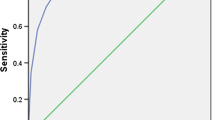Abstract
Objective
To investigate the important diagnostic indicators for blood stasis syndrome (BSS) in patients of childbearing age with gynaecological diseases.
Methods
A partial least squared-discriminant analysis (PLS-DA) were applied to BSS symptoms data of patients with gynaecological diseases, and the diagnostic indicators used by doctors of Korean medicine (DKMs) among BSS patients with gynaecological diseases were also investigated.
Results
A total of 103 patients of childbearing age with gynaecological diseases and 40 healthy controls were enrolled. Among the 103 patients, 63 (61.7%) and 40 (38.8%) were diagnosed with BSS and non-BSS, respectively, and BSS patients exhibited a more severe extent of disease. A score plot of PLS-DA showed clearly different patterns among the 3 groups. Based on the variable importance on projection of PLS-DA model, menstrual pains, dark lumps in the menstrual blood, ileocoecal tenderness and resistance, sharp pains, and sublingual varicosities were selected as the top five most important indicators. Moreover, more than 75% of DKMs chose dark lumps in menstrual blood, menstrual pain, and dark menstrual blood as the diagnostic indicators of BSS in patients with gynaecological diseases, and more than 49% of them also considered sharp pains, dark red tongue, sublingual varicosities, and tendency to bruise easily as diagnostic indicators of BSS.
Conclusion
DKMs focused on menstrual symptoms and certain gynaecological symptoms to diagnose BSS patients of childbearing age with female diseases.
Similar content being viewed by others
References
Chen KJ. Blood stasis syndrome and its treatment with activating blood circulation to remove blood stasis therapy. Chin J Integr Med 2012;18:891–896.
Li SM, Xu H, Chen KJ. The diagnostic criteria of bloodstasis syndrome: considerations for standardization of pattern identifi cation. Chin J Integr Med 2014;20:483–489.
Chen NN, Han M, Yang H, Yang GY, Wang YY, Wu XK, et al. Chinese herbal medicine Guizhi Fuling Formula for treatment of uterine fi broids: a systematic review of randomised clinical trials. BMC Complement Altern Med 2014;14:2.
Liu J, Li X, Hu X. Clinical observations on treatment of endometriosis by tonifying kidney and removing blood stasis. Chin J Integr Tradit West Med (Chin) 1998;18:145–147.
Shen BQ, Situ Y, Huang JL, Su XM, He WT, Zhang MW, et al. A clinical study on the treatment of chronic pelvic inflammation of qi-stagnation with blood stasis syndrome by Penyanqing Capsule. Chin J Integr Med 2005;11:249–254.
Zhou J, Qu F. Treating gynaecological disorders with traditional Chinese medicine: a review. Afr J Tradit Complement Altern Med 2009;6:494–517.
Park B, Yun KJ, Jung J, You S, Lee JA, Choi J, et al. Conceptualization and utilization of blood stasis syndrome among doctors of Korean medicine: results of a web-based survey. Am J Transl Res 2014;6:857–868.
Choi TY, Jun JH, Lee JA, Park B, You S, Jung J, et al. Expert opinions on the concept of blood stasis in China: an interview study. Chin J Integr Med 2016;22:823–831.
Terasawa K. The presentation of diagnostic criteria for “Yu-xie” (stagnated blood) conformation. Int J Orient Med 1989;14:194–213.
Yao KW, Chu FY, Wang J. A clinical epidemiological study of the quantitative diagnosis scale of blood stasis syndrome. Chin J Integr Med 2011;17:200–204.
Yang DH, Park YJ, Park YB, Lee SC. Development of questionnaire for blood stasis pattern. J Korea Inst Orient Diagn 2006;10:141–152.
Park YJ, Yang DH, Lee JM, Park YB. Development of a valid and reliable blood stasis questionnaire and its relationship to heart rate variability. Complement Ther Med 2013;21:633–640.
Eriksson L, Byrne T, Johansson E, Trygg J, Vikström C. Multi-and megavariate data analysis basic principles and applications. Umea: Umetrics; 2013:70–76.
The Society of Oriental Obstetrics and Gynecology. Oriental obstetrics and gynecology?. Seoul: Eui seong dang; 2012:86–92.
Yoon YJ. A fundamental study to make a questionnaire of blood stasis specially designed for Korean obstetrics and gynecology. J Orient Obstet Gynecol 2013;26:92–108.
Luo YK, ed. Reference book of traditional Chinese medicine gynecology. Beijing: People’s Medical Publishing House; 1988:27–53.
Zhang YZ, ed. New centry of traditional Chinese medicine gynecology. Beijing: China Press of Traditional Chinese Medicine; 2002:25–55.
Luo SP, Sun ZJ, eds. Traditional Chinese medicine gynecology. Beijing: Science Press; 2007:3–17.
Tanaka TH. Tongue diagnosis: relationship between sublingual tongue morphology in three tongue protrusion angles and menstrual clinical symptoms. J Integr Med 2015;13:248–256.
Shi ZX, Gu WL, Du JH, Jia HZ, Li G. Scheme of diagnostic criteria revision consideration on blood stasis syndrome. Chin J Integr Med Cardio Cerebrovasc Dis (Chin) 2007;5:1037–1039.
Acknowledgment
We are grateful to the physicians from Dong-guk Oriental Medical Hospitals who participated in this study.
Author information
Authors and Affiliations
Corresponding author
Additional information
Supported by the grant from Korea Institute of Oriental Medicine (No. K15111 and K15114)
Rights and permissions
About this article
Cite this article
Jung, J., Ko, M.M., Lee, M.S. et al. Diagnostic Indicators for Blood Stasis Syndrome Patients with Gynaecological Diseases. Chin. J. Integr. Med. 24, 752–757 (2018). https://doi.org/10.1007/s11655-017-2813-1
Accepted:
Published:
Issue Date:
DOI: https://doi.org/10.1007/s11655-017-2813-1




